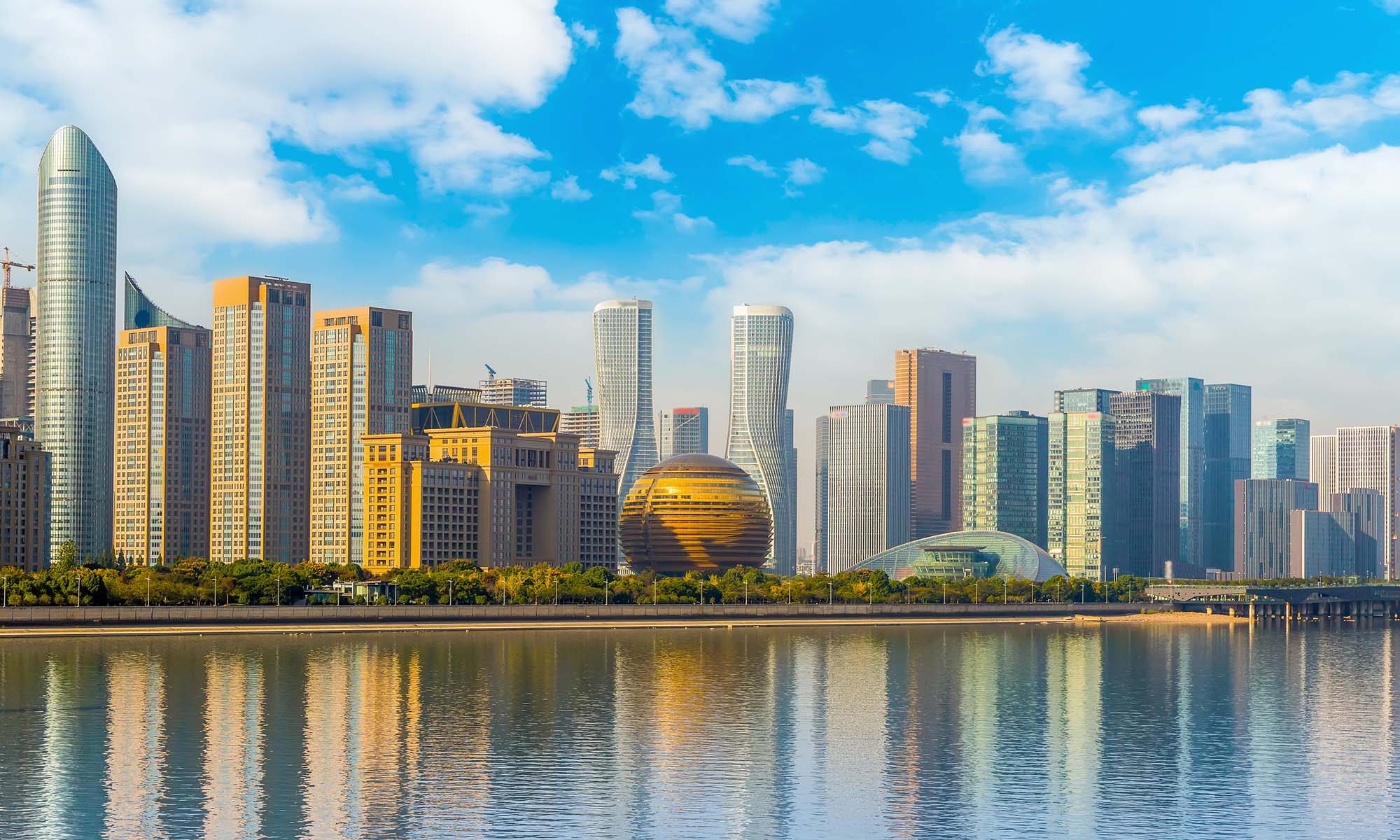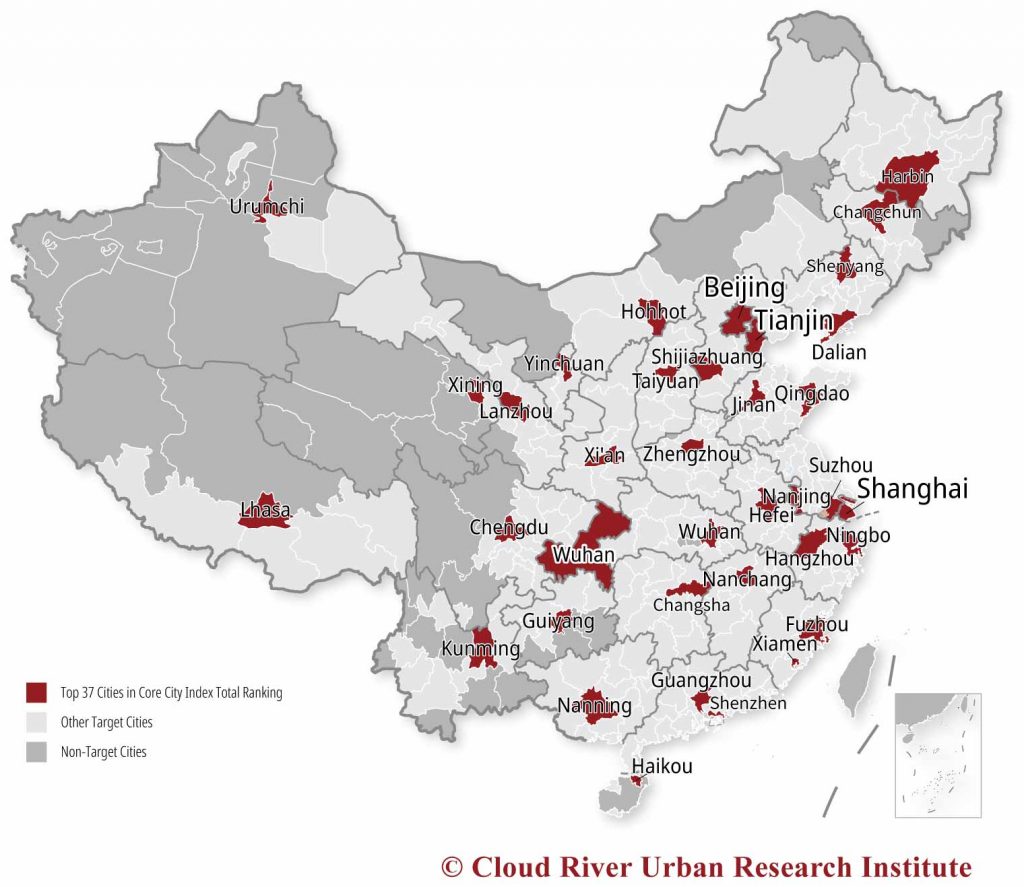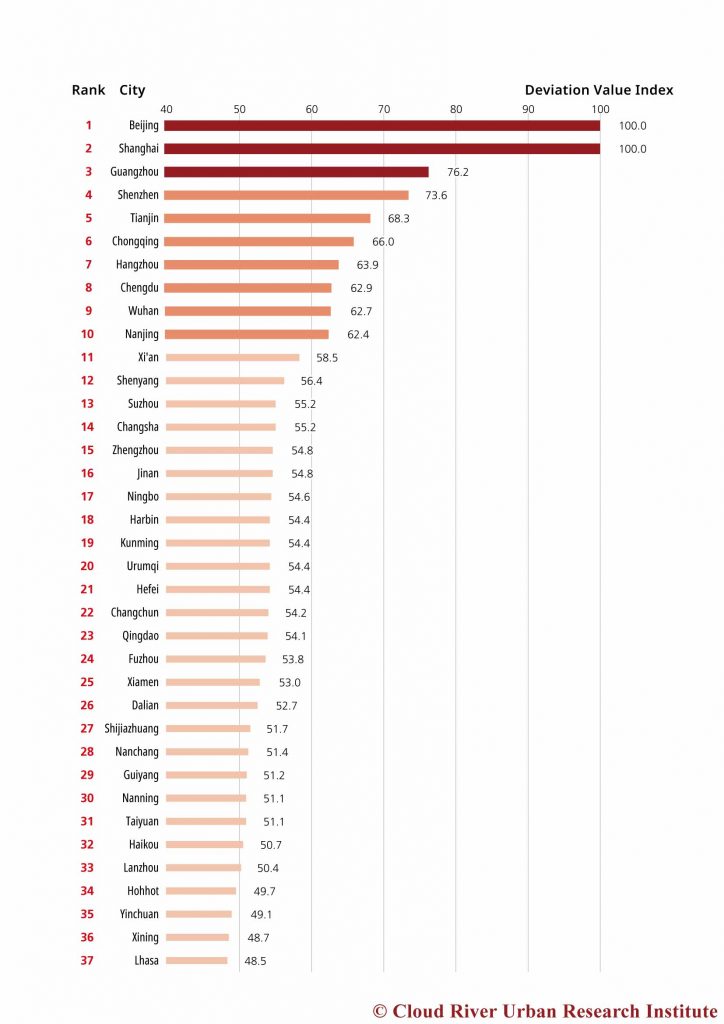China Core City Index 2017
1. About China Core City Index
The world embarking on the era of large cities and megacities was highly coincident with China’s reform and opening-up. During this period, China evolved her policy from de-urbanization to development of small towns, and then to new urbanization based on urban agglomerations. Also, China has begun her large-city-oriented and megacity-oriented urbanization.
Among the 92 world cities with a population growth of more than 2.5 million between 1980 and 2015, 30 were Chinese cities, accounting for nearly one third; among the 35 world cities with a population growth of more than 5 million, 12 were Chinese cities, accounting for over one third; and among the 11 world cities with a population growth of more than 10 million, 5 were Chinese cities, representing nearly one half.
During that period, China’s urban population increased by 380 million, accounting for 30% of the total growth of urban population around the world for the same time span. In China, there were 30 cities enjoying a population increase of more than 2.5 million, and in aggregate, the urban population of these 30 Chinese cities increased by 170 million, accounting for 33.4% of the total growth of urban population in the above-mentioned 92 world cities.
Based on the above data and analysis, it is evident that China’s rapid urbanization as well as large-city-oriented and megacity-oriented urbanization are highly resonant with the global trend at the same frequency.
It is even more noteworthy that the 30 Chinese cities with an urban population growth of more than 2.5 million are, likewise, predominantly administrative centers such as the capital, municipalities directly under the Central Government and provincial capitals, or coastal cities. This finding fully corresponds to the above analysis and inference of the relationship between large-city-oriented urbanization and core cities as well as coastal cities.
Today, for the above 30 Chinese cities, the total residents with household registration fall behind the total permanent residents by 70.22 million. In other words, there are more than 70 million migrants living in those 30 cities. The 30 cities that have attracted a large number of people contribute 39.2% of the total GDP, 67.0% of the total exports of goods, 58.1% of the total number of inbound tourists and 56.4% of the total amount of valid patent authorization in China. Moreover, 66.3% of the country’s mainboard listed enterprises are also concentrated in these 30 cities. It can be said that these cities have exactly led the development of China’s society and economy since the reform and opening-up.
Innovation and entrepreneurship are the most important means to pursue prosperity in the era of great integration and big transformation of exchange-and-trading-based economy. The number of listed companies can be used as a key index to measure the results of innovation and entrepreneurship. By using the China Integrated City Index 2017 and targeting the 297 cities at the prefecture level or above, the author has performed a correlation analysis for the relationships between the listed companies (on the main boards of Shanghai, Shenzhen and Hong Kong stock exchanges) and relevant indicators such as transportation hub, opening and communications, and radiation (i.e., the extent to which a city function is used externally).
The correlation analysis is a technique used to analyze the strength of correlation between two given factors. A “positive” correlation coefficient ranges between 0 and 1—the closer the coefficient is to “1”, the stronger the correlation is between two factors. Specifically, for the coefficient, the range of 0.9-1 is considered as “complete correlation”, 0.8-0.9 is considered as “extremely strong correlation”, and 0.6-0.8 is considered as “strong correlation”.
The above-mentioned analysis finds the following: The correlation coefficients between the listed companies and airport convenience, container port convenience, and railway convenience were respectively 0.79, 0.70, and 0.66, confirming a “strong correlation” between the number of listed companies and the elements of a city’s transportation hub; the correlation coefficients between the listed companies and import and export of goods, foreign investment utilized and inbound tourists were respectively 0.83, 0.74, and 0.71, confirming a “strong correlation” and “extremely strong correlation” between the number of listed companies and the elements of a city’s opening to and communications with the outside world; the correlation coefficients between the listed companies and financial radiation, IT radiation, wholesale and retail radiation, catering and hotel radiation, science and technology radiation, cultural and sports radiation and higher education radiation were respectively 0.97, 0.93, 0.89, 0.88, 0.88, 0.86 and 0.84, confirming an “extremely strong correlation” or even “complete correlation” between the number of listed companies and the various types of radiation of a city.
Evidently a strong correlation is existed between the listed companies and a variety of elements, such as transportation hub, opening and communications, and radiation. This means that the richness and strength of urban contents play a key role in determining the number of listed companies. In other words, the integration of various elements forms the basis for creating a new era of prosperity.
Of course, the richness and strength of urban contents imply that there will be a huge urban population. The correlation analysis further shows that the correlation coefficient between the number of listed companies and the size of DID population (population in densely inhabited districts) is as high as 0.85, which represents an “extremely strong correlation”.
However, the expansion of the size of urban population is a test to the carrying capacity of the city. By improving the level of infrastructure and urban management, cities are able to significantly increase their carrying capacity for alignment with the density and size of population. Taking the Greater Tokyo Metropolitan Area as an example: with a population of more than 10 million around 1950, this metropolitan area was once seriously plagued by “big city diseases” such as environmental pollution, traffic congestion, housing shortage and inadequate infrastructure, and was considered to be “too big” and “too dense”. To solve these problems, the Japanese government adopted a series of policies and measures to prevent population and industries from being concentrated and clustered in Tokyo and was even once preparing to relocate their capital. However, through improving the level of infrastructure and urban management, the carrying capacity of Tokyo has been greatly increased. This metropolitan area, where the population is now nearly 40 million, has become one of the most influential cities around the world, without any trace of “big city diseases”.
At the same time, however, many megacities in the world, such as São Paulo of Brazil, Mumbai of India, and Lagos of Nigeria, are still facing severe slum issues.
The development and governance of cities need urban intelligence—it is the different levels of urban intelligence that have led to the sharply different outcomes with an equally large population.
Large-city-oriented urbanization and megacity-oriented urbanization are essentially the competition between core cities. The key to the competition of core cities is to improve their siphonic capability of attracting and clustering people, funds and materials as well as their related carrying capacity, through developing and strengthening their central functions at the regional, national and global levels. Therefore, the way to appropriately evaluate, cultivate and enhance the central functions of cities should become an important national strategy for the purpose of wining in the global trend of large-city-oriented urbanization and megacity-oriented urbanization. As such, on the basis of the China Integrated City Index, this report develops and compiles the China Core City Index to classify and evaluate the primary central functions of Chinese cities as well as to provide an analysis for the ranking of central functions of 297 cities at the prefecture level or above in China.
The China Core City Index restructured the data in the China Integrated City Index that are strongly correlated to the evaluation of central functions of cities and regrouped them into 10 dimensions, including “city status, city power, radiation ability, wide-area hub, opening and communications, business environment, innovation and entrepreneurship, ecological resources and environment, quality of life, and culture and education”. Under each dimension, 3 sub-dimensions are set up, and each such sub-dimension is supported by several indicator groups, for the construction of a value system indicative of core cities and an indicator system for evaluating the central functions of cities.
China Core City Index is intended to, via the application of big data indicators, interpret changes in the pattern of the world and mechanisms in urban development, improve the level of urban intelligence, and make contributions to help Chinese cities win the competition of large-city-oriented urbanization and megacity-oriented urbanization.
2. Comprehensive Ranking of Core City Index
The top 37 cities in the comprehensive ranking of China Core City Index include all the municipalities directly under the Central Government, provincial capitals, and cities under independent planning, plus Suzhou.
It goes without saying that as the capital, Beijing wins the championship in the comprehensive ranking of China Core City Index. Specifically, Beijing ranks No. 1 in 7 out of the 10 dimensions, i.e., city status, city power, radiation ability, business environment, innovation and entrepreneurship, quality of life, and culture and education. Under the dimension of opening and communications, Beijing slightly falls behind Shanghai and ranks No. 2. Due to the inland location without any ports, Beijing ranks No. 3 under the dimension of wide-area hub. As a result of such issues as air quality and water shortage, Beijing also ranks No. 3 under the dimension of ecological resources and environment. All in all, Beijing is not only the most important core city in China and the core of the Beijing-Tianjin-Hebei Megalopolis, but also a cosmopolitan metropolis with great influence in the world.
As the primary core city in the Yangtze River Delta Megalopolis, Shanghai ranks No. 2 in the comprehensive ranking of China Core City Index, which is truly deserved. Among the 10 dimensions, Shanghai ranks No. 1 under wide-area hub, opening and communications, and ecological resources and environment; No. 2 under city status, city power, radiation ability, business environment, innovation and entrepreneurship, quality of life, and culture and education. So to speak, Shanghai is representative of the core cities in China and also a cosmopolitan metropolis that plays a decisive role in the global economy.
As the primary core city in the Pearl River Delta Megalopolis, Guangzhou ranks No. 3 in the comprehensive ranking of China Core City Index. Among the 10 dimensions, Guangzhou ranks No. 2 under wide-area hub; No. 3 under city status, business environment, quality of life, and culture and education. As a provincial capital, Guangzhou is advantaged and privileged in these dimensions. However, except radiation ability, Guangzhou has underperformed Shenzhen in all other dimensions. Guangzhou ranks No. 4 under city power and ecological resources and environment, No. 5 under radiation ability and innovation and entrepreneurship, and No. 6 under opening and communications.
Also a part of the Pearl River Delta Megalopolis, Shenzhen, neither a municipality directly under the Central Government nor a provincial capital, has taken advantage of its privileged position as a special economic zone and successfully leaped to the 4th place in the comprehensive ranking of China Core City Index. She is a typical new-born coastal megacity. Among the 10 dimensions, Shenzhen has done best in ecological resources and environment, securing the 2nd place. She ranks No. 3 under city power, opening and communications, and innovation and entrepreneurship, No. 4 under wide-area hub and business environment, and No. 8 under the quality of life. It can be said that both Guangzhou and Shenzhen, as twin stars of the Pearl River Delta Megalopolis, are representative core cities in China and also cosmopolitan metropolises catching significant attention in the development of global economy.
From No. 5 to No. 10 in the comprehensive ranking are Tianjin, Chongqing, Hangzhou, Chengdu, Wuhan, and Nanjing. These cities are quite remarkable for their ranking scores and have their respective edges. They are representative of the regional core cities in China.
Suzhou, No. 13 in the comprehensive ranking, is the only one among the top 37 core cities that is neither a provincial capital nor a city under independent planning. Without the support of (high) administrative level, Suzhou ranks No. 4 under opening and communications as well as innovation and entrepreneurship, No. 5 under business environment, and No. 7 under city power and ecological resources and environment. These excellent results are truly worth attention.
Also noteworthy is that Kunming and Urumqi have joined the top 20 club in the comprehensive ranking, mainly due to the geopolitical importance of their locations as border cities.
The top 37 core cities have contributed 40.7% of China’s GDP as well as 54.4% of patent authorization, 59.9% of goods exports, and 55.3% of inbound tourists in the country. As the most attractive carriers for migrants in the process of urbanization, these core cities today have accommodated 63.38 million residents without household registration. These cities have not only accounted for 25.4% of China’s population, but also 42.7% of the DID population in the country. A huge amount of high-density population and strong central functions have cultivated enormous creativity—the top 37 core cities have been responsible for incubating 72.4% of China’s mainboard listed enterprises, which are in turn leading the social and economic development of China.



